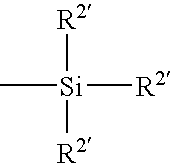Surface modified biomedical devices
a biomedical device and surface technology, applied in the field of surface modified biomedical devices, can solve the problems of eye discomfort, eye inflammation, and lens surface affecting the susceptibility of deposition, so as to prevent or limit the adsorption of tear lipids, improve the performance quality and/or comfort, and preserve the clarity of contact lenses
- Summary
- Abstract
- Description
- Claims
- Application Information
AI Technical Summary
Benefits of technology
Problems solved by technology
Method used
Image
Examples
example 1
[0085]Synthesis of Poly(glyceryl methacrylate-co-octafluoropentyl methacrylate) (“P(GM-co-OFPMA)”).
[0086]To a three-neck 500 l flask equipped with condenser and nitrogen inlet tube was added glyceryl methacrylate (9.724 g; 60.711 mmol), THF (200 ml), 1H,1H, 5H-octafluoropentyl methacrylate (4.481 g; 14.927 mmol), and AIBN (0.214 g; 1.303 mmol). The contents were bubbled vigorously with nitrogen for 20 minutes and then heated to reflux under the constant nitrogen flow overnight. A white product precipitated on the second day. The product was recovered by removal of solvent.
example 2
[0087]Preparation of Lens.
[0088]Monomer mixtures are made by mixing the following components listed in Table 1, at amounts per weight.
[0089]
TABLE 1Amount inIngredientweightID2S4H11TRIS35DMA10NVP40HEMAVC13-methoxy-1-butanol4Vazo-640.5Glycidyl methacrylate5IMVT150ppm
The resultant monomer mixtures are cast into contact lenses by introducing the monomer mixture to a mold assembly composed of a PP mold for the anterior surface and a PP mold for the posterior surface and thermally curing the monomer mixture at 100° C. for 2 hours. The contact lenses are released from the molds. Next, the lenses are placed in glass vials filled with a 1% solution of the copolymer of Example 1 in THF, and heated at 60° C. for 1 hour. The treated lenses are extracted with IPA overnight, rinsed with deionized water and autoclaved in a borate buffered saline to provide treated hydrogel lenses.
example 3
[0090]Preparation of isocyanatoethyl methacrylate functionalized Poly(glyceryl methacrylate-co-octafluoropentyl methacrylate).
[0091]To a three-neck 100 ml flask equipped with condenser, and nitrogen inlet tube, was added glyceryl methacrylate (2.746 g; 17.146 mmol), methanol (50 ml), 1H, 1H,5H-octafluoropentyl methacrylate (1.261 g; 4.199 mmol), and AIBN (0.068 g; 0.414 mmol). The contents were bubbled with nitrogen vigorously for 20 minutes. Next, the mixture was heated under reflux with constant nitrogen flow for two days. The solvent was then removed first under reduced pressure and then under high vacuum for 3 hours to provide a white polymer solid. Anhydrous THF (50 ml) was transferred to the flask containing the white polymer solid under the flowing of dry nitrogen and then DBTDL (0.04 g) and isocyanatoethyl methacrylate ((0.6585 g; (4.244 mmol)) were added to the flask. The contents were then stirred at room temperature for two days under nitrogen purging. The solution was th...
PUM
| Property | Measurement | Unit |
|---|---|---|
| mol % | aaaaa | aaaaa |
| mol % | aaaaa | aaaaa |
| mol % | aaaaa | aaaaa |
Abstract
Description
Claims
Application Information
 Login to View More
Login to View More - R&D
- Intellectual Property
- Life Sciences
- Materials
- Tech Scout
- Unparalleled Data Quality
- Higher Quality Content
- 60% Fewer Hallucinations
Browse by: Latest US Patents, China's latest patents, Technical Efficacy Thesaurus, Application Domain, Technology Topic, Popular Technical Reports.
© 2025 PatSnap. All rights reserved.Legal|Privacy policy|Modern Slavery Act Transparency Statement|Sitemap|About US| Contact US: help@patsnap.com



